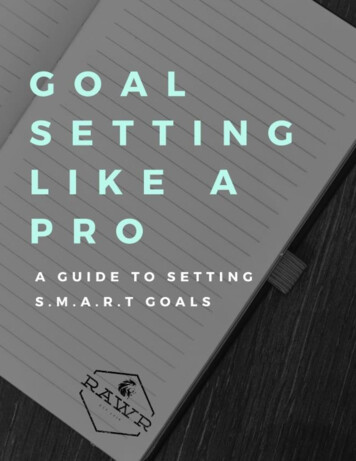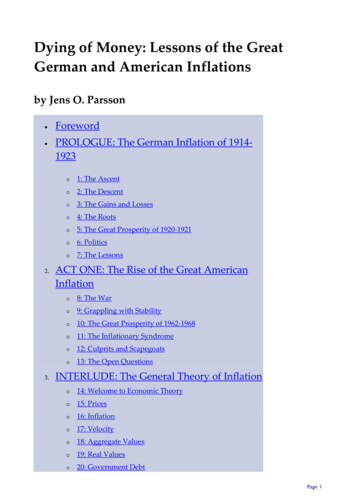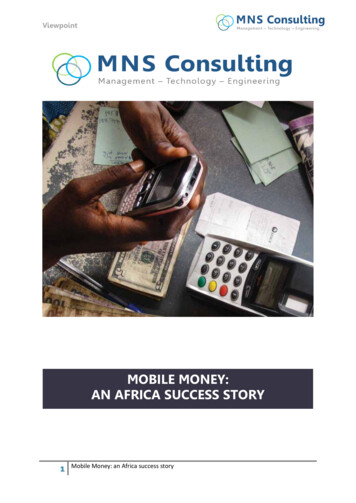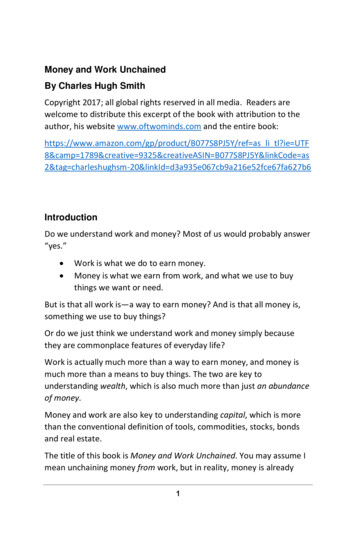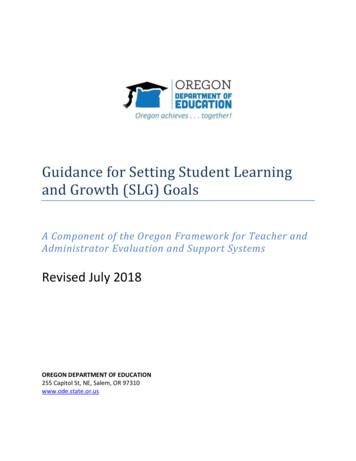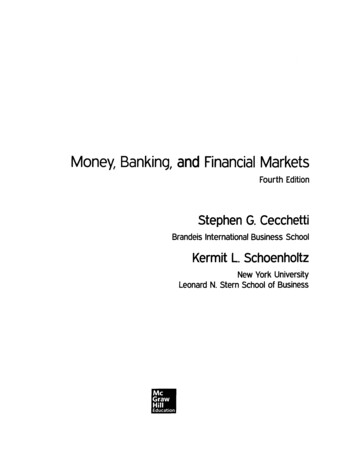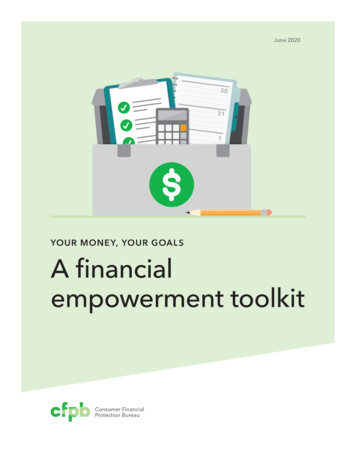
Transcription
June 2020YOUR MONEY, YOUR GOAL SA financialempowerment toolkitConsumer FinancialProtection Bureau
Table of contentsIntroduction . 6About the toolkit . 6The power of financial empowerment. 7Incorporating the toolkit into your work . 7Financial decisions are about more than money . 9Tool: Financial empowerment self-assessment. 13Tool: My money picture . 21Module 1: Setting Goals . 24Hopes and dreams can be turned into goals . 25Creating effective goals . 25Setting goals for life events and large purchases . 26Tool: Setting SMART goals. 29Tool: Putting goals into action . 32Tool: Planning for life events and large purchases .34Handout: Revising goals. 36Module 2: Saving . 38Reasons to save. 39Taking the first step to saving . 41Making savings automatic. 43TABLE OF CONTENTS1
You can save while receiving public benefits .43Tool: Savings plan. 45Tool: Saving and asset limits . 47Tool: Finding a place for savings . 50Handout: Saving at tax time. . 53Module 3: Tracking Income and Benefits . 55Income . 56Public benefits . 58Getting income and benefits. 58Protecting the money on your prepaid card . 59Deductions from your pay. 61Tool: Income and benefits tracker. 67Tool: Choosing how to get paid . 69Tool: Increasing income and benefits. 74Module 4: Paying Bills. 77Planning for bills . 78Wants versus needs. 78Making paying bills easier . 79Protecting your information on digital money apps . 79Tool: Spending tracker. 82Tool: Bill calendar . 85Tool: Choosing how to pay bills. 872YOUR MONEY, YOUR GOALS TOOLKIT
Tool: Cutting expenses. 91Tool: Prioritizing bills . 94Module 5: Getting through the Month . 97Making a cash flow budget . 98Analyzing your cash flow . 98Tool: Creating a cash flow budget .100Tool: Improving cash flow.103Tool: Adjusting your cash flow.108Module 6: Dealing with Debt . 110Making sense of debt .111Co-signers: Agree to repay the loan. 113Types of debt . 113Student loan debt. 114Medical debt . 116Payday loans. 117Auto title loans . 118Rent-to-own arrangements . 119Avoiding problems with debt . 119Tool: Debt log . 125Tool: Debt-to-income calculator. 128Tool: Debt action plan . 131Tool: Comparing auto loans. 133TABLE OF CONTENTS3
Tool: Repaying student loans. 136Tool: When debt collectors call . 143Handout: Avoiding medical debt. 150Module 7: Understanding Credit Reports and Scores . 152Why do credit reports and scores matter? . 153Credit reports . 154Credit scores . 165Using credit . 168Tool: Requesting your free credit reports. 171Tool: Reviewing your credit reports. 173Tool: Disputing errors on your credit reports. 176Tool: Getting and keeping a good credit history.180Module 8: Choosing Financial Products and Services . 183Finding and choosing financial products and services.184Opening a checking or savings account .184Using a prepaid card. 189Alternatives to prepaid cards. 191Tool: Finding financial products and services . 193Tool: Comparing financial service providers .205Tool: Opening a checking or savings account . 213Tool: Avoiding checking account fees. 216Tool: Evaluating your prepaid or payroll card .2204YOUR MONEY, YOUR GOALS TOOLKIT
Handout: Knowing your prepaid card rights.226Handout: Sending money abroad.227Module 9: Protecting your Money .229Ask questions.230Avoiding scams.230You can say no .232Guard your information .232Handout: Protecting your identity.235Handout: How to handle identity theft.237Handout: Spotting red flags .239Handout: Submitting a complaint. 241TABLE OF CONTENTS5
IntroductionWelcome to the Consumer Financial ProtectionBureau's Your Money, Your Goals: A financialempowerment toolkit!At a glanceThis introduction includes two tools to help you start using the Your Money, YourGoals toolkit. Financial empowerment self-assessmentUse this tool to develop an understanding of your own financial knowledge,skills, and confidence level. My money pictureUse this tool to help you assess each person’s goals and financial situation, soyou can determine which specific modules and tools will help them the most.About the toolkitThis toolkit is designed for anyone who serves people living with low incomesthrough non-profit, community-based, or private sector organizations or works in agovernment agency dedicated to helping the public.Many of the people you meet with may feel overwhelmed by their financialsituations, and they often don’t know where to go for help. You’re in a uniqueposition to provide that help. The people your organization works with alreadyknow and trust you. In many cases, they’re already sharing financial and otherpersonal information with you as well.This toolkit gives you the tools and information you need to help people set andachieve goals; build skills in managing money, credit, and debt; and choosefinancial products that are right for them. Each person has different circumstancesand things they can benefit from, so you can select the tools that best meet theirneeds and just work with those topics.: INTRODUCTION6
The power of financial empowermentYou may have heard the term “financial literacy” before. This concept describes theprocess of helping someone learn about financial topics.While financial empowerment includes the concept of financial literacy, it goesbeyond just acquiring knowledge. The main focus of financial empowerment isto build the skills you need to manage money and learn to choose the financialproducts and services that work for you.When you’re financially empowered you’re both informed and skilled. You knowwhere to get help with your financial challenges and can access and choosefinancial products and services that meet your needs. This sense of empowermentbuilds confidence, helping you effectively use your financial knowledge, skills, andresources to reach your goals.If you feel knowledgeable about financial topics and comfortable in your ownapproach to money management, credit, debt, and financial products, you canbetter help others face money issues that may be complicating their lives.The modules of this toolkit teach you about important financial topics andprovide tools so you can put this information into practice with the people youhelp every day.Incorporating the toolkit into your workThe Your Money, Your Goals toolkit is comprehensive and brings togetherinformation, tools, and links to other resources you can use to help people buildskills in managing money, credit, debt, and financial products. Having all theseresources in one place can make it easier for you to bring financial empowermentconcepts into conversations you may already be having. This can help the peopleyou work with increase the financial stability in their lives.Sharing information and tools may feel like a completely different job from yourcurrent one— another thing you’re being asked to add to your workload. But onceyou’re familiar with the resources in this toolkit, it can become natural to integrateits contents into the work you do every day.7YOUR MONEY, YOUR GOALS TOOLKIT
This toolkit provides the tools and information you need to help the people youserve take steps toward financial empowerment. It can help them: Set goals and calculate how much money they need to save to reachthese goals Plan for large purchases and life events Learn to effectively save money Establish an emergency savings fund Get tax refunds and put the funds toward achieving their goals Track the specific ways they are using their money Bring their cash flow budgets into balance Make a simple plan to pay down debt Get, review, and fix errors on their credit reports Evaluate financial products and services Learn how to protect themselves from identity theft and fraudThe toolkit helps you identify and share the information and tools that can besthelp someone get started on solving specific financial challenges and reachingtheir goals. And when they want or need additional help, the aim is to help yourefer them to the appropriate resource in your community.This toolkit is different from a financial education curriculum. While a curriculumgenerally follows a specific order and has a concrete set of goals, this toolkit can beused in whatever order best suits each person’s needs. Their goals and obstaclesare what dictate which tools and information from this toolkit should be used.Each person’s needs are unique and often complex. Even when there are multipleissues to address, you shouldn’t try to cover all the information and tools witheveryone you serve.Covering all the tools at once, or even a few tools at one time, would beoverwhelming for most people. Only review one or two tools at a time, beginningwith a key topic and the tools that make the most sense for their situation.: INTRODUCTION8
Financial decisions are about more than moneyFinancial decisions, no matter how well intended, are never made in a vacuum.Many things influence both our short- and long-term financial decisions.Your values, culture, and traditions may play a part in how you spend, save, andmake financial choices. For example, you may have to choose between usingyour tax refund to build an emergency fund, using it to pay down your debts, orspending it to pay off your mother’s medical bills. Your values and culture influenceyour financial decisions.LISTEN FOR THE EMOTIONS BEHIND FINANCIAL DECISIONSWhen people talk about money, it’s not just about the numbers. They're alsodiscussing what money means to them. Attitudes and behaviors around moneyare wrapped up in feelings around security, failure, family, love, and status. It’simportant to listen carefully to try to help people understand their emotionalreactions to money. Then you can bring in their emotions and feelings into yourdiscussions about the tools.Instead of just asking someone to give you the basic numbers, try includingquestions about how they feel when you’re discussing their finances. You could tryquestions like: What does money mean to you? What is your first memory about money? What is the most difficult thing about money for you? For your family?Helping people become aware that financial decisions can be influenced byemotions and past experiences can help them understand what drives some oftheir financial choices now. It can also help you better understand their uniquestrengths and challenges when dealing with money issues or problems.UNDERSTANDING VALUES AROUND MONE YDecisions, including financial ones, are made within the very powerful contextsof culture, including family, ethnicity, region, community, socio-economic status,generation, and religion. Each of these factors can influences beliefs, values, andexperiences about money and the way financial decisions are handled.Our unique values shape how we prioritize what we do with our time, energy, andmoney. In just a single day, we make many choices about “what is more important”in terms of how we spend our money.9YOUR MONEY, YOUR GOALS TOOLKIT
These choices are guided by our values, for example: The enjoyment of eating out at a restaurant versus saving money and eatingat home Giving a loved one an expensive gift versus spending less and savingthe difference Paying for financial obligations, such as child support or student loans, beforespending money for “wants”When you spot what might be someone’s core value, name the value and askfollow-up questions to help define the value: It sounds like being a source of support to your siblings is really important toyou. Would you agree with that? What makes helping your siblings important to you?NAVIGATING DIFFERENCES IN MONE Y VALUESDifferences in cultural values can affect financial behavior. For example, Westernculture is often considered to value individuality and personal well-being, whichmeans it’s generally considered appropriate for each person to support themselvesfinancially. In some other cultures, family or community members support eachother financially throughout their lives. If someone chooses to spend their extraincome on their extended family or neighbors instead of saving it in an emergencyfund, this doesn’t mean that they have bad financial habits. They may just bemaking financial choices in a cultural context that is different from your own.It’s important to understand cultural influences without being judgmental. Thiscan help you discuss financial decision-making in a way that makes the peopleyou serve feel understood and respected. They might agree to a financial planthat makes rational sense at the time, but this is often not enough to override theirfeelings or cultural context in the moment when decisions are actually made.This can make it much more difficult to stick to a plan that doesn’t align with theirvalues or cultural norms. Remember, priorities that may be surprising to you maymake perfect sense for someone else given each person's background, values,and culture.CONFLIC TS AROUND CULTURE AND VALUESSometimes you may find that people are caught in the middle of cultural conflictsaround money. Their family culture may value saving and avoiding debt. But theirbroader community may value material things like new cars or expensive clothes,which could lead to taking on debt to purchase. Or the culture in which a person: INTRODUCTION10
was raised might value caring financially for parents as they age, while anotherperson, based on their family circumstances and traditions, might not be expectedto take on that same responsibility.Conflicts can also take place within a family. One parent may want to save thefamily’s tax refund; the other thinks the money should go toward things thefamily needs, like clothes for school. These kinds of conflicts can be stressful andconfusing. They can lead to decisions that are based more on emotions or outsidepressures, rather than on what’s in their financial plan.A SKING QUESTIONS TO UNDERSTAND WHAT’S BEHIND DECISIONSWhen discussing people’s financial behavior, try to uncover the motivationbehind their answers. Take time to ask questions that can help you discover theirunderlying attitudes, needs, goals, and challenges.Ask questions like: Who handles the finances in your family? How did your family handle finances when you were growing up? Did youdiscuss money openly? How do your friends view money? How do you think this may influence you? What do you want your children to learn about money? What do you think theyare learning from you now?It’s often difficult for people to open up about money, but taking the time to helpa person talk about and understand their values and attitudes about money canprovide both you and the people you serve with new insights. These insights canhelp them make lasting and productive changes that help them reach their goals.Once you understand the values and cultural factors that guide someone’sbehavior, you can help them identify ways their financial choices align with theirtrue values, desires, and their goals.KEEPING YOUR PERSONAL VALUES IN CHECKAs you talk with the people you serve, it’s important to remember that you haveyour own attitudes and feelings toward money.Your own values about money and financial issues may affect the way you approachfinancial empowerment with the people you serve. Your attitudes and feelings maybe different than theirs, and that may mean your ideas about what’s “best” can be11YOUR MONEY, YOUR GOALS TOOLKIT
different from theirs. Be sure that you aren’t offering advice based solely on yourown preferences and values.It can sometimes be tempting to “set someone’s priorities straight,” or tell themwhat you would do in their situation. Ultimately, this isn’t a successful strategy.Information, advice, and other support will only help when it’s aligned with aperson’s own deeply rooted beliefs and values.In fact, imposing your own values on someone else can be counterproductive.The person might feel judged and stop talking with you about money andfinancial decisions.Rather than telling someone which is the “better” course of action, ask questionsthat help identify the risks and rewards of each choice: If you continue on this path, what is the short-term gain or thelong-term impact? Does this financial choice help you and your family get to where youwant to go? Who in your life will be affected by this course of action and how?Then, stop and listen. Let the person tell you what is important to them and askfollow-up questions. People can often be led to the best choices by just talkingthrough the “risks and rewards” of their options.BAL ANCING VALUES AND GOAL SKeeping your personal values in check doesn’t mean that you shouldn’t helppeople understand the consequences of their choices. While you should work tounderstand and respect a person’s perspectives and values, you should also makesure that they understand the potential long-term consequences of their decisions.Choices made today might support or limit options tomorrow for helping a familymember in need, starting a family business, or saving for a car or home.Once someone understands their core values and how they influence financialchoices, you can help them understand how a new or different financial behavior isin line with their existing values. This can help them take ownership of their plan orgoal, rather than just trying to do what they think they’re “supposed to do.”: INTRODUCTION12
GET TING STARTEDFinancial empowermentself-assessmentTake this self-assessment to better understand your ownfinancial knowledge, skills, and overall confidence.As someone who helps your organization serve individuals and families, it’s importantfor you to understand your own level of financial empowerment. The questions askedin this assessment are directly related to the module topics contained within theYour Money, Your Goals toolkit. This tool has three parts: Part 1: What you know helps you benchmark your knowledge, so you know whereto build upon and fill in the missing gaps Part 2: How you feel helps you identify how you feel about your ownfinancial life Part 3: Your experiences helps you understand which financial products andservices you’re familiar with and which are new to youWhat to do Answer the questions in Part 1 and compare your responses with the answer key.If you didn’t answer an item correctly, review the toolkit module listed next to theanswer for more information. Answer the questions in Part 2. There are no right or wrong answers herebecause it’s about your own financial knowledge, feelings, and situation. Answer the questions in Part 3. There are no right or wrong answers herebecause you’re identifying your experiences. This is important because thepeople you’re working with may have experienced situations or used productsand services you haven’t.A step furtherIf parts 1 or 3 of this tool reveal topics you’re not familiar with, take a look at therelevant modules. This information can help you build knowledge and confidence.: INTRODUCTION13
SELF-ASSESSMENTPart 1: What you know.Decide if each of the following statements is true or false.STATEMENTTRUEFAL SE1. Only income and expenses matter when you’re making a budget.2. To have enough money for an emergency, you must save at least 3 to 6months’ worth of living expenses.3. If you make and stick to a monthly budget, you’ll be able to pay yourbills on time.4. If you can’t pay all of your bills and debt collectors are calling, just paythe one who calls the most.5. The only way to receive employment income is a paycheck.6. Credit is when you owe someone money.7. Your total monthly debt payments may affect your ability to borrowmore money.8. A poor credit history can keep you from getting an apartment, and insome states, insurance or even a job.9. The only cost of having a checking account is the monthly service fee.10. As a consumer, you have almost no rights when it comes tofinancial products.: INTRODUCTION14
SELF-ASSESSMENTPart 2: How you feel. .Use check marks to show how you feel today about each statement.Then tally up the total number of check marks in each column atthe bottom.STATEMENTAGREE1. I have enough money set aside foremergencies and goals.2. I am not worried about how muchmoney I owe.3. I am confident about how to makesure the information on my creditreports is correct.4. I don’t worry about being able topay my bills and expenses.5. I understand how credit works.6. I feel confident about helpingpeople begin to manage financialchallenges.7. I know where to get help if I havean issue with a financial product orservice.8. I know where people in mycommunity can get financialcounseling and free tax filingassistance.TOTAL15YOUR MONEY, YOUR GOALS TOOLKITDISAGREENOT SURE /DOESN’ T APPLY
SELF-ASSESSMENTPart 3: Your experiences.Use check marks to show your level of experience with the conceptdescribed in each statement.STATEMENTYESNOI DON'T KNOW1. I have a savings or checking account at abank or credit union, and I use it regularly.2. I have applied for, received, and used acredit card.3. I have used a loan to help me purchase a caror a home.4. I have taken out a payday loan or an autotitle loan.5. I have requested my own credit report andreviewed it.6. I make and stick to a budget.7. I have used a check cashing business.8. I have been contacted by debt collectors.9. I understand my rights and know what to doif I believe a financial services provider hastried to take advantage of me.10. I receive income via a method other than apaycheck (payroll card, direct deposit, orcash, for example).: INTRODUCTION16
Answer key for Part 1: What you knowCheck your answers for “Part 1: What you know.” If there are any you're unsure of or that youanswered incorrectly, review the module listed for more information. Reading through the modulecan help you build your financial knowledge and confidence.STATEMENTTRUEFAL SEMODULE1. Only income and expenses matter whenyou’re making a budget. 1 Setting Goals2. To have enough money for an emergency,you must save at least 3 to 6 months’ worthof living expenses. 2 Saving3. If you make and stick to a monthly budget,you’ll be able to pay your bills on time. 5 Getting through4. If you can’t pay a
Module 1: Setting Goals 24 . Hopes and dreams can be turned into goals 25 . Creating effective goals 25 . Setting goals for life events and large purchases 26 . Tool: Setting SMART goals29 . Tool: Putting goals into action32 . Tool: Planning for life events and large purchases 34 . Handout: R
